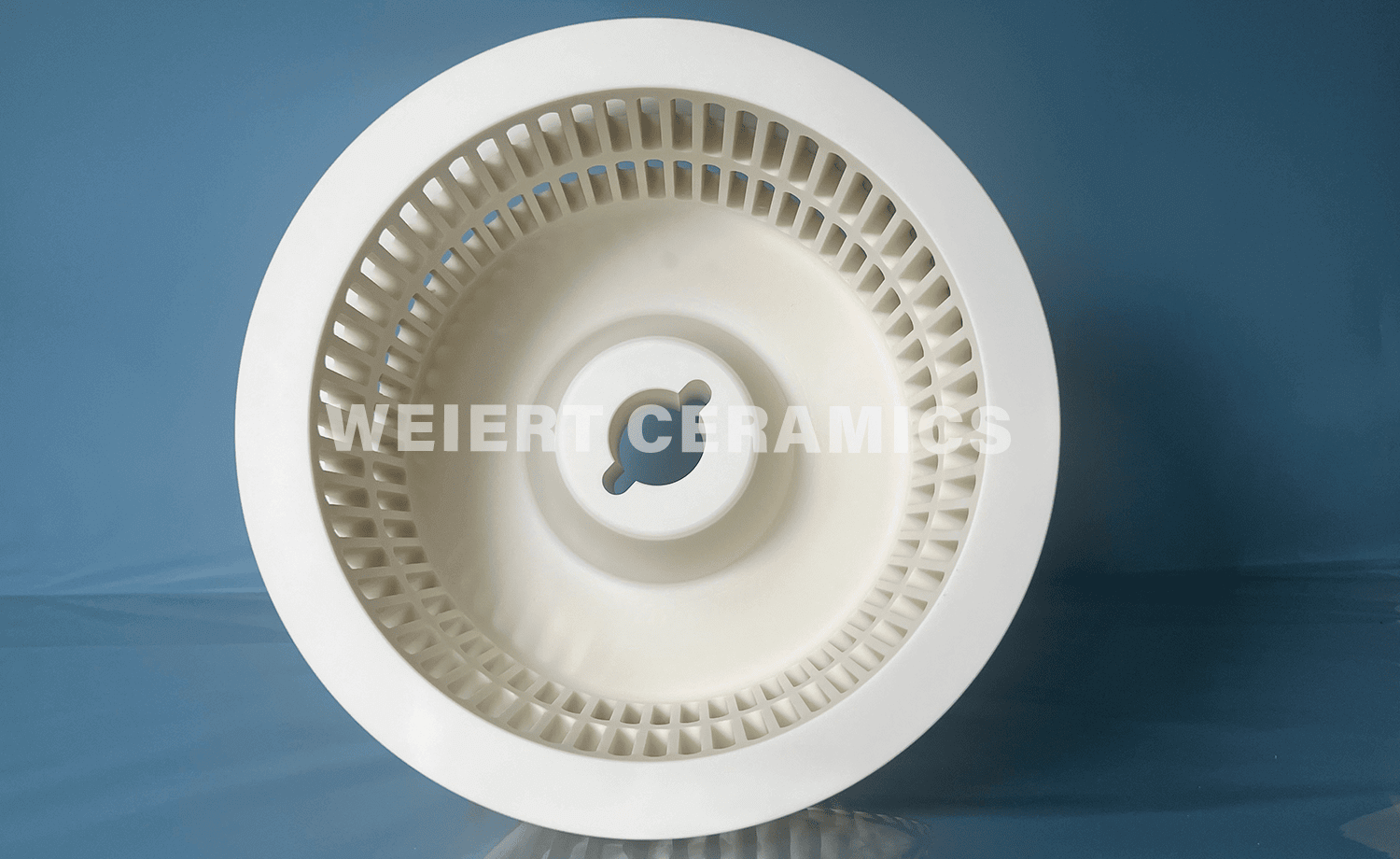Tehnologia de clasificare ultrafină a pulberilor separă cu precizie particulele de dimensiuni micron, folosind echipamente specializate. Este aplicat pe scară largă la pulberile ultrafine nemetalice și la alte materiale în industrii precum electronica, ceramica avansată și acoperirile la temperatură înaltă.
Clasificatorul de aer este o parte esențială pentru prelucrarea pulberilor ultrafine. Componentele sale principale includ admisia, admisia aerului, evacuarea, corpul conic, camera de clasificare și motorul. Principiul de lucru se bazează pe viteza de rotație reglabilă a roții de clasificare, care generează forță centrifugă și interacționează cu fluxul de aer care intră prin admisia de aer. Aceste forțe influențează mișcarea particulelor de diferite dimensiuni în camera de clasificare, realizând o separare foarte precisă a dimensiunii particulelor.
Roata clasificatoruluis sunt il esenţial componente pentru clasificator de aers si sunt realizate în general din materiale metalice sau nemetalice. Pentru aplicațiile în care contaminarea magnetică trebuie evitată, se folosesc de obicei roți de clasificare nemetalice și sunt fabricate din ceramică avansată, cum ar fi zirconiu, alumină sau carbură de siliciu.
Fabricarea unei roți de clasificare ceramică integrată prezintă două provocări principale: sinterizarea și prelucrarea CNC. În cele din urmă, trebuie să ne asigurăm că roata trece testele de echilibrare dinamică chiar și la viteze de până la 6,000 RPM, astfel încât să poată menține o funcționare stabilă și eficientă în timpul utilizării efective.
Distribuția eficientă în interiorul camerei de clasificare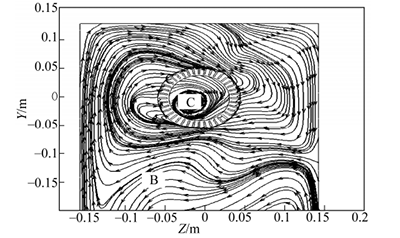
Imaginea ilustrează în continuare distribuția conductelor de gaz în secțiunea longitudinală a camerei de clasificare. După cum se arată în figură, fluxul de aer formează vârtejuri orizontale neregulate în jurul roții clasificatoare. Este de remarcat faptul că fluxul de aer în regiunea exterioară a acestui tip de roată clasificatoare curge în aceeași direcție cu rotația roții, iar modelele de flux în interiorul și în exteriorul roții clasificatoare sunt consecvente.
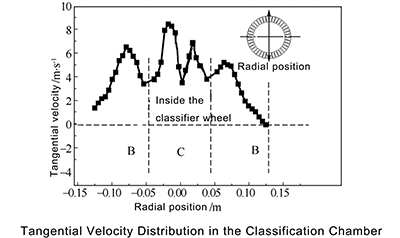
În clasificarea centrifugă a pulberilor ultrafine, mărimea vitezei tangențiale afectează direct forța centrifugă experimentată de particule. Distribuția vitezei tangențiale în camera de clasificare este prezentată în figură. Pentru acest tip de clasificator, viteza tangențială în camera de clasificare este în întregime pozitivă. Pe măsură ce fluxul de aer intră în golurile dintre paletele rotorului, viteza tangențială rămâne stabilă. Acest lucru previne discrepanțe în viteza tangențială între regiunile interioare și exterioare ale roții de clasificare, evitând astfel distribuția neuniformă a câmpului de forță la marginea exterioară a roții, care altfel ar reduce eficiența clasificării particulelor.
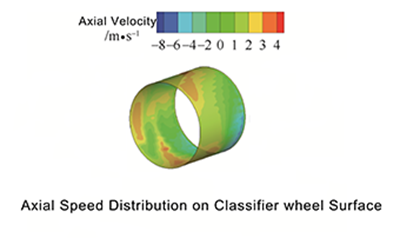
Imaginea afișează o diagramă de contur a distribuției vitezei axiale pe suprafața cilindrică a unei roți de clasificare cu un diametru exterior de 100 mm. Distribuția axială a vitezei pe suprafața exterioară a roții de clasificare pentru acest clasificator este relativ uniformă, cu valori ale vitezei apropiate de zero în majoritatea zonelor. Orice prezență a vitezei axiale ar duce la fluctuații ale vitezei fluxului de aer, care sunt dăunătoare pentru menținerea unui câmp de curgere stabil și ar avea un impact negativ asupra preciziei de clasificare.
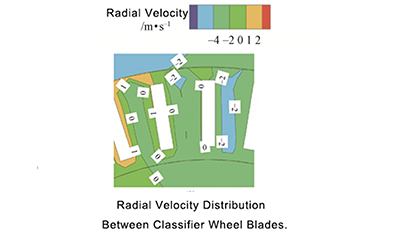
Imaginea prezintă o diagramă de contur a distribuției vitezei radiale a fluxului de aer între paletele roții de clasificare, unde simbolul „-” indică gazul care curge spre centrul rotorului. Din imagine, se poate observa că viteza radială dintre paletele acestei roți clasificatoare variază în intervalul de -2~1m/s, distribuția vitezei fiind relativ uniformă.
WEIERT CERAMICS TECHNOLOGY este a producător direct a ceramicii tehnice din China — nu un intermediar comercial. Furnizăm componente ceramice de înaltă performanță producătorilor de echipamente de procesare a pulberii și oferim soluții directe utilizatorilor finali ai acestor sisteme.
Cu aproape 10 ani de experiență în producția de ceramică tehnică, suntem încrezători în capacitatea noastră de a livra roți de clasificare ceramice personalizate de înaltă calitate și alte produse ceramice tehnice. Dacă sunteți în căutarea unui partener de încredere pentru soluții ceramice, contactați-ne acum! Sunt încrezător că prețurile noastre competitive vă vor lăsa cu un zâmbet larg!
Referințe:
[1] SHAPIRO M,GALPERIN V.Clasificarea aerului a particulelor solide: a recenzie[J].Inginerie chimică și procesare,2005,44(2):279-285.
[2] XU N,LI G,HUANG Z.Simularea numerică a mișcării particulelor în turbo classifier[J].China Particuology,2005,3(5):275-278.
[3] 2016,22(2):82-85.DANG D,WANG KJ.Efectul vitezei roții clasificatorului asupra particulelor distribuția dimensiunilor[J].China Powder Science and Technology,2016,22(2):82-85.
[4] 2015,66(s1):159-164. DANG D,WANG KJ.Efectul ratei de alimentare asupra câmpului de curgere din interior clasificator[J].Journal of Chemical Industry and Engineering (China), 2015,66(s1):159-164.
[5] TONEVA P,EPPLE P,BREUER M,et al.Slefuire în aer Moara de clasificare — Partea I: Caracterizarea monofazelor flow[J].Powder Technology,2011,211(1):19-27.
[6] TONEVA P,WIRTH KE,PEUKERT W.Slefuire într-un clasificator de aer moara—Partea II:Caracterizarea fluxului bifazic[J].Pulbere Technology,2011,211(1):28-37.
[7] JIANG SZ,GE XL,WANG JX.Studiul câmpului de curgere pe orizontală turbo classifier[J].Non-Metallic Mines,1999,22(3):35-37.
[8] WANG X,GE X,ZHAO X,et al.Studiu asupra turbinei orizontale classification[J].Powder Technology,1999,102(2):166-170.
[9] LIU D,SONG Y.Studiu experimental al structurii discului ghid al FJJ model de clasificator vortex[J].Sulphur Phosphorus & Bulk Materials Handling Related Engineering,2012,111(6):13-15.
[10] SUN ZP,SUN GG,XU J.Efectul deflectorului asupra clasificării performanța unui clasificator turbo orizontal[J].China Powder Science And Technology,2016,22(1):6-10.
[11] BAUDER A,MÜLLER F,POLKE R.Investigații privind mecanism de separare în clasificatoare cu roți deflectoare[J].International Journal of Mineral Processing, 2004, 74: S147-S154.
[12] REN WJ,LIU JX,YU Y.Proiectarea unei cuști rotorului cu arc neradial lame pentru clasificatoare de aer turbo[J].Tehnologia pulberilor,2016,292:46-53.
[13] YUE DX,DIAO X,LI SY,et al.Calcul dimensiunii de tăiere a clasificatorului bazat pe analiza urmelor de particule[J].Industria chimică și Engineering Progress,2012,31(9):1919-1925.
[14] TONG C,LI SY,LI X.Simulare numerică pe particule traiectorie de clasificare folosind urmărirea instabilă[J].Industria chimică and Engineering Progress,2013,32(9):2061-2067.
